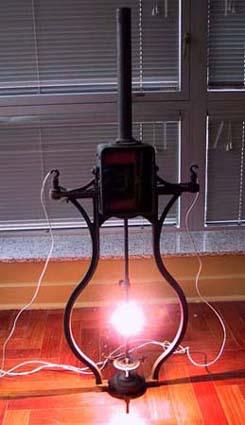
| |
 |
![]()
 Carbon Arc is full spectrum, equivalent to sunlight, and thus its potential as a grow light for indoor gardens and to prevent
Vitamin D deficiency in the gloom of the Aftertime. The Electric Museum reports on an old lamp pulled from a junk pile,
and lit!
Carbon Arc is full spectrum, equivalent to sunlight, and thus its potential as a grow light for indoor gardens and to prevent
Vitamin D deficiency in the gloom of the Aftertime. The Electric Museum reports on an old lamp pulled from a junk pile,
and lit!
These lamps are each about four feet tall, solid iron, and each weighs a considerable amount. The tube extending out the top Lamps like these could produce between 2,000 and 4,000 candle power. In 1880 Wabash Indiana had used just four Brush lamps of similar design to light the entire town and earn itself the title of first city anywhere to be wholly electrically lit. Remember that this was a time when gas and kerosene lighting were common. Incandescent lamps were just starting to show up in a few cities for indoor lighting, but could only produce about 16 candle power Carbon arc was a proven and established technology, and remained the brightest artificial light source until fairly recently.
The photo on the right shows the first lighting of this arc lamp in probably well over 100 years. The last time this lamp operated was in a world of gas lamps and horse drawn carriages. At the time most people had never seen an electric light before. Just imagine what it would have been like to see a 3,000 candle power arc lamp when all you knew were relatively dim gas and kerosene lamps. In this shot the camera's lens flare exaggerated the arc. Here the lamp is being powered by a very simple current limited DC power supply, and the cover is off the lamp mechanism.
When using Carbon Arc, consider this as sunlight, and protect the eyes and even the skin if exposed for long periods of time. Wear sunglasses. When Carbon Arc was used routinely for lighting movie scenes, the actors would develop skin cancers and deep tans as though they had been outside in sunlight!